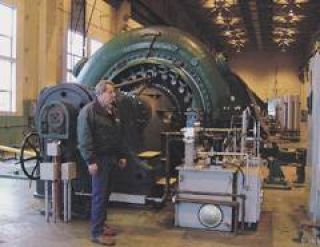By Dennis Box, The Courier-Herald
At 1 a.m. on Jan. 15, the four generators at the White River hydropower plant came to a quiet stop. After 92 years of producing electricity, Puget Sound Energy closed the plant as an electrical power producing facility.
"It's a sad day, to close it down," Charles Morton, manager of the White River facility, said, as he walked past the silent generators. "But times have changed and we have to go with the flow. The company did everything possible to find a solution that would work and you can't say enough for the Lake Tapps Task Force."
PSE decided on Nov. 21, 2003, that continued operation of the hydroelectric facility was economically untenable.
"This project, built nearly a hundred years ago, does not pencil out under today's environmental and engineering standard," PSE director of energy production and storage, Ed Schild, said in a Jan. 15 press release. "With the new federal operating conditions we faced, the project's output would have cost our customers roughly twice as much as other power resources available today."
The plant was caught in the crossfire between the National Oceanic and Atmospheric Administration (the agency charged with protecting endangered Chinook salmon) and the Federal Energy Regulatory Commission (the agency that issues operating licenses to energy facilities).
In 1997 FERC's environmental protection requirements for obtaining a license made the White River facility economically unsustainable in the view of PSE. The death blow came in November 2003 when fish biologist Steve Franzen of NOAA filed a report that said the hydroelectric plant was a threat to Chinook salmon because it drew too much water from the White River.
PSE has long diverted water from the river through a series of flumes and canals into Lake Tapps. The lake is a diked reservoir designed to store water for the power plant. It was built between 1908 and 1911. Fourteen dikes were built to surrounded four small lakes - Tapps, Kirtley, Crawford and Church.
Since 1997, when the potential closing of the power plant first came to light, the survival of Lake Tapps has been in jeopardy. The Lake Tapps Task Force was formed in 1999 in an attempt to save the lake. That group includes homeowners, elected officials, PSE, Cascade Water Alliance and representatives of the U.S. Army Corps of Engineers.
Now that the effort to salvage the power plant as a means to save Lake Tapps has come to an end, the next step will be to convert the lake, which is owned by PSE, into a municipal water right.
PSE secured the consumptive water right from the Department of Ecology in July 2003 with the intent to sell it to Cascade Water Alliance. The water right is facing an appeal brought by the Puyallup and Muckleshoot Indian tribes, the cities of Auburn, Buckley, Pacific and Algona and a private citizen. It is scheduled to go before the Pollution Control Hearing Board in October.
"This is the dark shadow that we need to be aware of," according to Pierce County Councilman Shawn Bunney, who is also co-chair of the Lake Tapps Task Force. "My hope is a settlement can be reached prior to the hearing. It's win or lose when you go to court, but it can be win-win if a settlement can be reached."
The stakes for saving Lake Tapps, both for recreational and financial reasons, are mounting with each passing day.
"The next milestone will be the potential sale of the consumptive water right, which is under appeal," PSE spokesman Roger Thompson said. "If we can get the water right upheld that will be a major step. We are talking with both the Muckleshoot and Puyallup tribes to see if there is a way to mutually address everyone's concerns and goals and protect the fish. From our standpoint the water right protects the fish, which is a valuable resource."
All parties involved in the appeal have agreed to not discuss the details of the negotiations.
Before the power plant closed, an interim protection agreement was signed by PSE and the federal government, represented by the U.S. Corps of Engineers, and approved by both NOAA and the U.S. Fish and Wildlife Service.
The interim agreement allows PSE to continue diverting water into Lake Tapps and keeps the Corps' fish trap for spawning salmon operational. The fish trap is used by the Corps to trap and truck salmon around Mud Mountain Dam, a key component to the lake's survival.
The agreement assures that water will continue to flow into Lake Tapps.
"I'm very concerned about setting the proper amount of water for the fish and vitality of the lake," Bunney said. "The water needs to circulate and flush to stay fresh. We need to figure out how to keep water in the lake to protect everyone's interest. Protecting the water quality and educating people on the best practices for taking care of the lake are very important."
Bunney said a Lake Tapps Management Agreement between the homeowners association and PSE is nearing completion. The agreement will assure a recreational water level between April and October and assign stewardship details between homeowners and PSE. It is another step in the complex process of preserving Lake Tapps.
Dennis Box can be reached at dbox@courierherald.com


